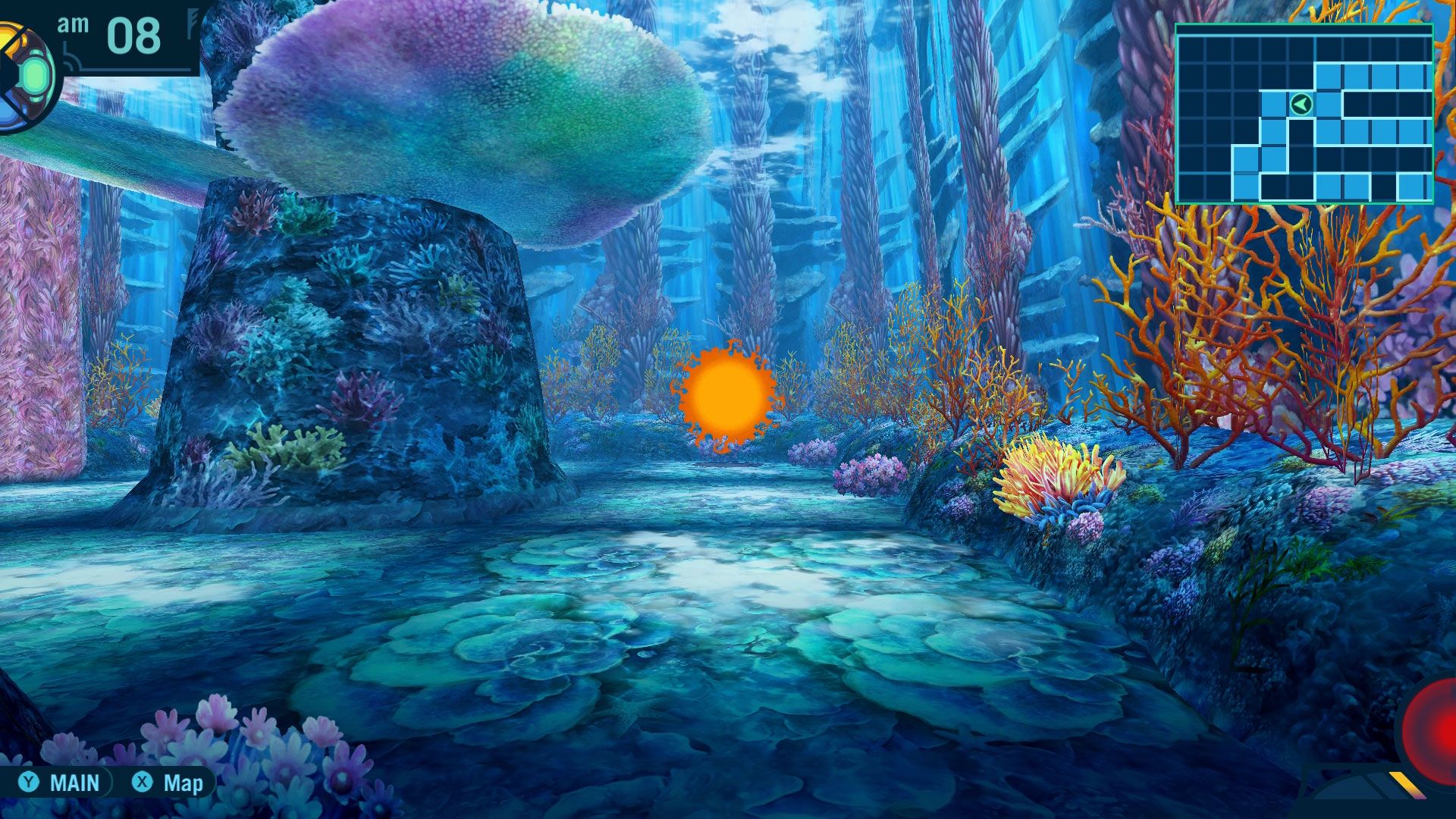Etrian Odyssey III HD
Few titles embody the ingenuity and novelty of the Nintendo DS as well as the Etrian Odyssey series. The series takes the classic dungeon-crawling formula of games like Ultima and Wizardry and updates it with colorful anime-inspired visuals and pumping tracks composed by the great Yuzo Koshiro. However, the true innovation of the series is the unique dual-screen features; unlike the dungeon crawlers of old, reams of graph paper and hand-sketched maps became obsolete. Instead, players could chart the maps on the bottom screen using the stylus while the exploration and battles occur on the top screen. The combination of nail-bitingly difficult turn-based combat, careful resource management, and player-driven cartography endeared the series to old-school RPG fans and introduced newcomers to the first-person dungeon crawler genre.
As the DS handheld line came to its end, many fans feared that the series would end with it because the dual screen format is so central to the series’ identity. The series clung to life on the 3DS for as long as it could, with Nexus as the last release on that platform in 2019 (long after the Switch had taken over the handheld market). Now, after four years of uncertainty, the series has finally made the jump to both single-screen and HD with a collection of HD remasters of the first three titles. While the seamless and tactile nature of the cartography suffers, this new HD adaptation manages to preserve most of the core experience while expanding the series’ reach to new platforms.
The underwater world of Etrian Odyssey III truly shines in this remaster.
Of the three games offered in the Origins Collection, I was looking forward to Etrian Odyssey III HD the most. For those unfamiliar with the history, Etrian Odyssey I & II previously received remakes on 3DS. For many years, the entire Etrian Odyssey series was playable in an updated form on the 3DS… except Etrian Odyssey III: The Drowned City. It was a great shame to see Etrian Odyssey III neglected because it was such a pivotal moment for the series. It was the first game to introduce an entirely new set of classes, first to introduce subclassing and forging weapons, and first to introduce exploration-based side content. These new features combined with the oceanic setting give the game a unique feel compared to the other EO games, and this still holds true for the HD version. Party building has much more depth due to subclasses, and well-worn strategies based on the classes in EO I & II won’t get you far in EO III.
You begin your journey in Armoroad, a city by the sea, forming an adventuring party and delving into the depths of the labyrinth beneath the waves. You can choose five party members from any of the ten classes available at the start, with two additional classes unlocked through story progression. Each of these ten classes is distinct, and not all of them abide by traditional RPG roles. You’ve got your tanky Hoplites and healing Monks, but there are also varied support or utility classes, such as the buff-focused Sovereign or the decoy-creating Ninja.
While a party of five may seem limiting, you unlock the ability to assign subclasses to your characters after completing the second Stratum of the labyrinth, opening up each character’s potential exponentially. Want the powerful direct healing of a Monk with the passive healing of a Sovereign? You can do that. Want a sturdy Hoplite that can copy itself to guard twice as many party members? Subclass as a Ninja and you can do that too! The possibilities feel endless, and each class feels suited to more than one role, or at least some variation of playstyle within their role. While many players may choose to use their magic-wielding Zodiac as an elemental damage dealer, I focused mine on the skill Dark Ether to make him into a TP battery for my more powerful physical damage dealers. Some class combinations are more efficient and complimentary than others, but nearly any class and combination can be viable. This level of experimentation and variety makes EO III a joy to play and replay.
Each class has a wide variety of skills to give you the upper hand in battle.
One unique element of EO III is the Farmer class. This class can exist in the main party as a form of support, but its true value is in forming a gathering party comprised entirely of Farmers. Gathering points are dotted throughout the labyrinth, and Farmers harvest resources more efficiently from these points than any other class. Harvested resources are your main source of income, and selling them to the shop unlocks the majority of new weapons, armor, and consumable items for purchase. Farmers have various skills that enable them to harvest more times per spot, find better items while harvesting, and avoid combat entirely. This creates a gameplay loop in which your combat party will enter new dungeon floors and map the layout to discover hidden paths. Then, you will return to the dungeon floor with your gathering party, taking the optimal route to the gathering spots, and then hurry back out of the dungeon. This loop is immensely satisfying and adds further weight to the cartography gameplay as an additional incentive to map out all the shortcuts for return trips to previously conquered floors.
Another element unique to EO III is seafaring exploration. This side content isn’t necessary for completing the game, but it does provide additional rewards, money, and some discoveries can cause new objectives to appear within the main labyrinth. Much like traditional dungeon crawling, your ship will move turn by turn on a grid-based ocean map. However, the number of turns is limited by your supplies. Supplies that grant more turns unlock from visiting certain places on the map. Through these limitations, seafaring becomes more of a puzzle, as you must figure out how to get to where you need to go in a limited number of turns while navigating obstacles and avoiding pirates. These mechanics wouldn’t be enough to carry a full game, but they serve as a pleasant diversion for breaking up the repetition of dungeon crawling. The rewards for fully exploring the oceans surrounding Armoroad are well worth the effort.
Ocean exploration is a fun diversion.
As an adaptation of the DS original to HD platforms, EO III HD is mostly a success. Easily the strongest aspects of this remaster are the retouched visuals and music. From the moment you pull up the title screen, you are greeted with Yuzo Koshiro’s masterful compositions in much better audio quality than the modest DS could provide. The 2D character and monster portraits are stunning in HD, as are the colorful and detailed graphics of the labyrinth. The game is so visually arresting that as I was playing, my partner peered over my shoulder and remarked, “Wow, that’s really pretty!” Overall, this HD version is an immense success from a presentation standpoint.
Unfortunately, the transition from dual screen to single screen was not as kind to the cartography mechanics. I played the game on Switch exclusively in handheld mode with a Switch-compatible stylus. If you are interested in playing the game on Switch, this is my recommended approach. Atlus did include button controls for mapping, but they feel very clunky. Drawing walls requires holding down the trigger then using the right stick to draw the line. Changing between the mapping tools, points of interest markers, and back to the map is an exercise in frustration, so much so that I wouldn’t recommend playing the game on the TV with a controller under any circumstances. Even with auto-mapping of walls and floors turned on, you will still be adding doors and points of interest to the map constantly. I commend Atlus for attempting to provide an entirely controller-based control scheme, but it doesn’t work in practice. I don’t have any experience with the PC version of this release, but mapping works with the mouse cursor in that version, and that control method seems just as precise as using a stylus with the touch screen on Switch.
Having the map take up half the screen isn’t ideal, but it’s still the best way to play.
The presentation of the map is also an issue: without the second screen, the map has to share space with the action. You can switch between the map taking up the right half of the screen or shrinking the map down into a more limited mini-map in the upper right corner. This is functional, but it does negatively impact the visual presentation significantly. Either you have the gameplay screen space cut in half, or you have a full view of the dungeon with a woefully limited map view that doesn’t allow you to see far enough ahead. I ended up playing with the full map view open at all times during dungeon exploration, but I sorely missed the seamlessness of drawing out the maps on the bottom touch screen. Even with a stylus, the Switch touchscreen isn’t as precise as that of the DS with its fine-point stylus. Ultimately, the cartography gameplay is functional on Switch but not as intuitive as the DS original, and the degraded mapping experience is the biggest drawback of this HD version.
If you are a dungeon-crawling fan or an EO series veteran and you haven’t played Etrian Odyssey III before, you owe it to yourself to play this game. If you are new to the series or dungeon crawlers in general, then pick up the entire Origins Collection. The new lower-difficulty modes can ease you in, and the mapping gameplay can be de-emphasized through the use of auto-mapping if the cartography put you off in the past. If you’ve played EO III before, the sheer quality of the visual and audio improvements are enough to make this version worth a purchase, even with the lackluster map-making. Etrian Odyssey III HD is a beautiful version of an excellent dungeon-crawling adventure.
Source: RPGFan


